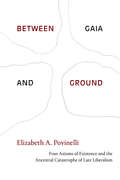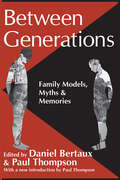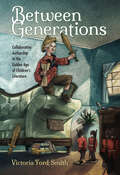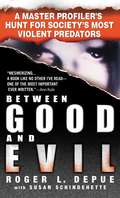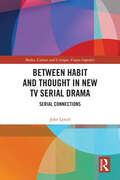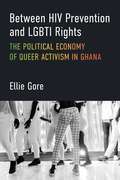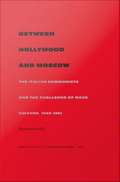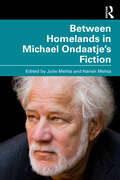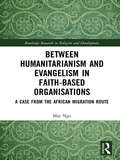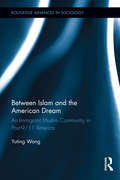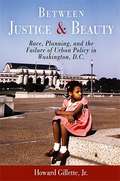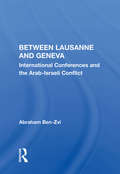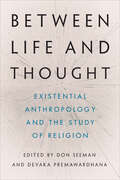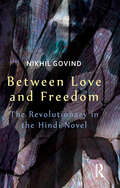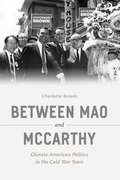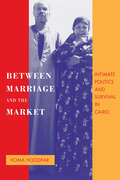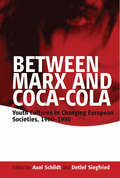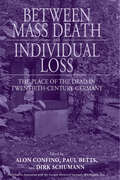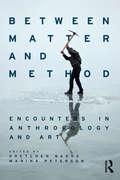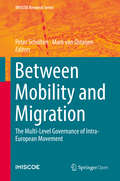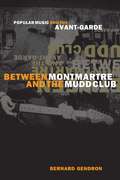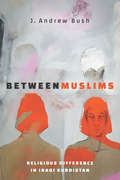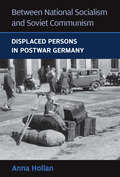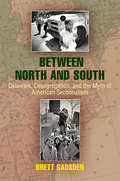- Table View
- List View
Between Gaia and Ground: Four Axioms of Existence and the Ancestral Catastrophe of Late Liberalism
by Elizabeth A. PovinelliIn Between Gaia and Ground Elizabeth A. Povinelli theorizes the climatic, environmental, viral, and social catastrophe present as an ancestral catastrophe through which that Indigenous and colonized peoples have been suffering for centuries. In this way, the violence and philosophies the West relies on now threaten the West itself. Engaging with the work of Glissant, Deleuze and Guattari, Césaire, and Arendt, Povinelli highlights four axioms of existence—the entanglement of existence, the unequal distribution of power, the collapse of the event as essential to political thought, and the legacies of racial and colonial histories. She traces these axioms' inspiration in anticolonial struggles against the dispossession and extraction that have ruined the lived conditions for many on the planet. By examining the dynamic and unfolding forms of late liberal violence, Povinelli attends to a vital set of questions about changing environmental conditions, the legacies of violence, and the limits of inherited Western social theory. Between Gaia and Ground also includes a glossary of the keywords and concepts that Povinelli has developed throughout her work.
Between Generations: Family Models, Myths and Memories (Memory And Narrative Ser.)
by Daniel Bertaux & Paul ThompsonBetween Generations concerns powerful memories that continue to shape the present, but in this case in almost all families throughout the world. What is it that parents pass down to their children? How can we understand the mixture of conscious and unconscious models, myths, and material inheritance that are intertwined in both family and individual life stories? These questions turn out to be unexpectedly complicated, and answering them has suggested how a life-story approach can provide a new key to research on the dynamics of the family and on social change. Because culture is the essence of what makes individual humans into a group, the core of human social identity, its continuity is vital. Cultures are always changing, but the stability of languages, religions, and cultural habits can be astonishing. In contrast to the claims of culture to represent tradition over centuries, stands the sheer brevity of individual human life. Hence, the universal necessity for transmission between generations exists. This edition in the Memory and Narrative series, brings together, contributions from the Americas and Asia as well as from Western and Eastern Europe. They combine the techniques of life story research with the insights of family therapy. Interdisciplinary and intellectually stimulating, the volume will appeal to students in many areas, including history, sociology, literature, psychology, and anthropology.
Between Generations: Collaborative Authorship in the Golden Age of Children's Literature (Children's Literature Association Series)
by Victoria Ford SmithWinner of the Children’s Literature Association’s 2019 Book AwardBetween Generations is a multidisciplinary volume that reframes children as powerful forces in the production of their own literature and culture by uncovering a tradition of creative, collaborative partnerships between adults and children in nineteenth- and early twentieth-century England. The intergenerational collaborations documented here provide the foundations for some of the most popular Victorian literature for children, from Margaret Gatty's Aunt Judy's Tales to Robert Louis Stevenson's Treasure Island. Examining the publication histories of both canonical and lesser-known Golden Age texts reveals that children collaborated with adult authors as active listeners, coauthors, critics, illustrators, and even small-scale publishers. These literary collaborations were part of a growing interest in child agency evident in cultural, social, and scientific discourses of the time. Between Generations puts these creative partnerships in conversation with collaborations in other fields, including child study, educational policy, library history, and toy culture. Taken together, these collaborations illuminate how Victorians used new critical approaches to childhood to theorize young people as viable social actors. Smith's work not only recognizes Victorian children as literary collaborators but also interrogates how those creative partnerships reflect and influence adult-child relationships in the world beyond books. Between Generations breaks the critical impasse that understands children's literature and children themselves as products of adult desire and revises common constructions of childhood that frequently and often errantly resign the young to passivity or powerlessness.
Between Good and Evil: A Master Profiler's Hunt for Society's Most Violent Predators
by Roger L. Depue Susan SchindehetteThe FBI's former top hunter of serial killers shares his unique perspective as both a lawman and a member of the clergy counseling convicts--revealing the dangerously thin line between good and evil.
Between Habit and Thought in New TV Serial Drama: Serial Connections (Media, Culture and Critique: Future Imperfect)
by John LynchBetween Habit and Thought in New TV Serial Drama: Serial Connections is a consideration of some of the key examples of serial television drama available via transnational streaming platforms in recent times. Through the individual works examined, the book exemplifies the ways in which aesthetics, technology, and capitalism weave a complex social fabric around the production of the respective television series, thus presenting this type of serial drama as a finely engineered cultural production. Taking Bernard Stiegler’s notion of an "image warfare" as its starting point, the author critically investigates the strategies deployed by the shows’ producers to navigate this dynamic, shaped by the "new spirit of capitalism". With creativity intrinsic to the process, on the one hand, and a highly efficient drive for capturing and fixing attention driven by algorithm and economic logic, on the other, the author maps the processes at work in the production of high-value serial drama and considers how, despite this tension, they manage to present meaningful insights into the experience of being in this world: A world shaped by trauma, a desire for justice, and a search for systems of belief that can offer a way through the vicissitudes of contemporary life. Framed by a detailed analysis of the multiple processes that shape these works is a sustained analysis of the serials Mr Robot, Billions, The Leftovers, Rectify, and Westworld, and the dynamics of despair and hope that ripple through them. As such, it will appeal to readers of film and television studies, cultural theory, and those interested in furthering a critical aesthetics for our time.
Between HIV Prevention and LGBTI Rights: The Political Economy of Queer Activism in Ghana (African Perspectives)
by Ellie GoreBetween HIV Prevention and LGBTI Rights investigates the transformative impacts of global development's sexual rights agenda on queer politics and activism in Ghana. With queer men bearing a disproportionate burden of HIV in Africa, rights-based health interventions have sought to tackle the epidemic by bringing together, educating, and ‘empowering’ queer African communities. Gore argues that queer Ghanaian men are not benefiting from development’s turn to sexual health and sexual rights. Instead, HIV and other sexual rights–based initiatives operate through neoliberal paradigms that reinforce class divides and de-politicize queer struggle. These dynamics are further shaping and shaped by the politicization of homophobia within the contemporary Ghanaian state. Gore combines original ethnography, documentary analysis, and the examination of development and global health data to connect the struggle for queer liberation in Ghana to broader trajectories of capitalist transformation and crisis and the afterlives of colonialism. In doing so, Between HIV Prevention and LGBTI Rights offers fascinating insights into the political economy of sexuality and global development for scholars, activists, and policymakers seeking to understand and address sexual injustice and oppression, both in Africa and beyond.
Between Hollywood and Moscow: The Italian Communists and the Challenge of Mass Culture, 1943-1991
by Stephen GundleIn the postwar years, Italy underwent a far-reaching process of industrialization that transformed the country into a leading industrial power. Throughout most of this period, the Italian Communist Party (PCI) remained a powerful force in local government and civil society. However, as Stephen Gundle observes, the PCI was increasingly faced with challenges posed by modernization, particularly by mass communication, commercial cultural industries, and consumerism. Between Hollywood and Moscow is an analysis of the PCI's attempts to cope with these problems in an effort to maintain its organization and subculture. Gundle focuses on the theme of cultural policy, examining how the PCI's political strategies incorporated cultural policies and activities that were intended to respond to the Americanization of daily life in Italy. In formulating this policy, Gundle contends, the Italian Communists were torn between loyalty to the alternative values generated by the Communist tradition and adaptation to the dominant influences of Italian modernization. This equilibrium eventually faltered because the attractive aspects of Americanization and pop culture proved more influential than the PCI's intellectual and political traditions. The first analysis in English of the cultural policies and activities of the PCI, this book will appeal to readers with an interest in modern Italy, the European left, political science, and media studies.
Between Homelands in Michael Ondaatje’s Fiction
by Edited by Julie Banerjee Mehta and Harish C. MehtaBetween Homelands in Michael Ondaatje’s Fiction is a comprehensive study of the novels of the Sri Lankan-Canadian author and poet, Michael Ondaatje. This survey of the Booker Prize-winning novelist’s works locates him as a powerful voice that urges globalization and multiculture in a world that is closing its borders. It reconnoitres Ondaatje’s search for a homeland by cracking open the core of his evocative, inventive, and innovative concepts that undergird his art of storytelling. The contributors in this volume examine themes such as literary cosmopolitanism, Sri Lankan identity, diasporic identity, race and racism, home and belonging, trauma in the Sri Lankan civil war, war games, and uncertainty theory.An important contribution to Ondaatje studies, the book is an indispensable resource for students and researchers of Sri Lankan literature, diasporic and world literatures, South Asian and Canadian studies, cultural studies, postcolonial fiction, and history.
Between Humanitarianism and Evangelism in Faith-based Organisations: A Case from the African Migration Route (Routledge Research in Religion and Development)
by May NgoReligion has always played an important, if often contested, role in the public domain. This book focuses on how faith-based organisations (FBOs) interact with the public sphere, showing how faith-based actors are themselves shaped by wider processes and global forces such as globalisation, migration, foreign policy and neoliberal markets. Focusing on a case study of an FBO in Morocco which gives aid to sub-Saharan African irregular migrants, the book reveals some of the challenges the organisation faces as it tries to negotiate at once local, national and international contexts through their particular Christian values. This book contends that the contradictions, tensions and ambiguities that arise are primarily a result of the organisation having to negotiate a normative global secular liberalism which requires a strict demarcation between religion and politics, and religion and the secular. Faith-based actors, particularly within humanitarianism, have to constantly navigate this divide and in examining the question of how religious values translate into humanitarian and development practices, categories such as religion, the secular and politics and the boundaries between them will need to be interrogated. This book explores the diversity and complexity of the work of FBOs and will be of great interest to students and researchers working at the intersections of humanitarianism and development studies, politics and religion.
Between Islam and the American Dream: An Immigrant Muslim Community in Post-9/11 America (Routledge Advances in Sociology #119)
by Yuting WangBased on a three-year ethnographic study of a steadily growing suburban Muslim immigrant congregation in Midwest America, this book examines the micro-processes through which a group of Muslim immigrants from diverse backgrounds negotiate multiple identities while seeking to become part of American society in the years following 9/11. The author looks into frictions, conflicts, and schisms within the community to debunk myths and provide a close-up look at the experiences of ordinary immigrant Muslims in the United States. Instead of treating Muslim immigrants as fundamentally different from others, this book views Muslims as multidimensional individuals whose identities are defined by a number of basic social attributes, including gender, race, social class, and religiosity. Each person portrayed in this ethnography is a complex individual, whose hierarchy of identities is shaped by particular events and the larger social environment. By focusing on a single congregation, this study controls variables related to the particularity of place and presents a “thick” description of interactions within small groups. This book argues that the frictions, conflicts and schisms are necessary as much as inevitable in cultivating a “composite culture” within the American Muslim community marked by diversity, leading it onto the path of Americanization.
Between Justice and Beauty: Race, Planning, and the Failure of Urban Policy in Washington, D.C.
by Howard Gillette Jr.As the only American city under direct congressional control, Washington has served historically as a testing ground for federal policy initiatives and social experiments—with decidedly mixed results. Well-intentioned efforts to introduce measures of social justice for the district's largely black population have failed. Yet federal plans and federal money have successfully created a large federal presence—a triumph, argues Howard Gillette, of beauty over justice. In a new afterword, Gillette addresses the recent revitalization and the aftereffects of an urban sports arena.
Between Lausanne And Geneva: International Conferences And The Arab-israeli Conflict
by Abraham Ben-ZviThis book analyzes the concept of an international conference as referred to by the major parties involved to resolve at least one facet of the Arab-Israel predicament. The restrictive type of conference has proved to be effective in resolving or stabilizing certain elements of the conflict.
Between Life and Thought: Existential Anthropology and the Study of Religion
by Don Seeman Devaka PremawardhanaExistential anthropology is an approach inspired by existential and phenomenological thought to further our understanding of the human condition. Its ethnographic methodology emphasizes embodied experience and focuses on what is at stake for people amid the contingencies, struggles, and uncertainties of everyday life. While anthropological research on religion abounds, there has been little systematic attention to the ways anthropology and religious studies might benefit from better consideration of one another or from the adoption of a shared existential perspective. Between Life and Thought gathers leading anthropologists and religion scholars, including some of existential anthropology’s most recognized advocates and thoughtful critics. The collection opens with a comprehensive introduction to phenomenology and existentialism in anthropology and religious studies and concludes with an analysis of how existential anthropology might address the long-standing problem of constructivism and perennialism in religious studies. The chapters altogether present existential anthropology as an especially generative paradigm with which to rethink and remake both anthropology and the academic study of religion. A timely and significant intervention across multiple areas of research, Between Life and Thought is an invaluable source for critically exploring the prospects, as well as the limits, of an anthropological approach to religion grounded in experiential ethnography and existential thought.
Between Love and Freedom: The Revolutionary in the Hindi Novel
by Nikhil GovindBetween Love and Freedom interprets the figure of the revolutionary in the Hindi novel by establishing its lineage in representative Bengali novels, as well as in the contending moralities of Mahatma Gandhi and Bhagat Singh on the idea of violence. It reveals how conventional social realism and emergent modernist modes were brought together in the novelistic tradition by extending the political ideal of anti-colonial revolution into domains of sexual desire and subjective expression, especially in the works of Agyeya, Jainendra, and Yashpal. This work will deeply interest scholars and students of literature, modern Indian history, Hindi, and political science.
Between Mao and McCarthy: Chinese American Politics in the Cold War Years
by Charlotte BrooksDuring the Cold War, Chinese Americans struggled to gain political influence in the United States. Considered potentially sympathetic to communism, their communities attracted substantial public and government scrutiny, particularly in San Francisco and New York. Between Mao and McCarthy looks at the divergent ways that Chinese Americans in these two cities balanced domestic and international pressures during the tense Cold War era. On both coasts, Chinese Americans sought to gain political power and defend their civil rights, yet only the San Franciscans succeeded. Forging multiracial coalitions and encouraging voting and moderate activism, they avoided the deep divisions and factionalism that consumed their counterparts in New York. Drawing on extensive research in both Chinese- and English-language sources, Charlotte Brooks uncovers the complex, diverse, and surprisingly vibrant politics of an ethnic group trying to find its voice and flex its political muscle in Cold War America.
Between Mao and McCarthy: Chinese American Politics in the Cold War Years
by Charlotte BrooksDuring the Cold War, Chinese Americans struggled to gain political influence in the United States. Considered potentially sympathetic to communism, their communities attracted substantial public and government scrutiny, particularly in San Francisco and New York.Between Mao and McCarthy looks at the divergent ways that Chinese Americans in these two cities balanced domestic and international pressures during the tense Cold War era. On both coasts, Chinese Americans sought to gain political power and defend their civil rights, yet only the San Franciscans succeeded. Forging multiracial coalitions and encouraging voting and moderate activism, they avoided the deep divisions and factionalism that consumed their counterparts in New York. Drawing on extensive research in both Chinese- and English-language sources, Charlotte Brooks uncovers the complex, diverse, and surprisingly vibrant politics of an ethnic group trying to find its voice and flex its political muscle in Cold War America.
Between Marriage and the Market: Intimate Politics and Survival in Cairo (Comparative Studies on Muslim Societies #24)
by Homa HoodfarHoma Hoodfar's richly detailed ethnography provides a rare glimpse into the daily life of Arab Muslim families. Focusing on the impact of economic liberalization policies from 1983 to 1993, she shows the crucial role of the household in survival strategies among low-income Egyptians. Hoodfar, an Iranian Muslim by birth, presents research that undermines many of the stereotypes associated with traditional Muslim women. Their apparent conservatism, she says, is based on rational calculation of the costs and benefits of working within formal and informal labor markets to secure household power. She posits that increasing adherence to Islam and taking up the veil on the part of women has been partially motivated by women's desire to protect and promote their interests both within and beyond households.
Between Marx and Coca-Cola
by Axel Schildt Detlef SiegfriedIn the 1960s and 1970s, Western Europe's "Golden Age" (Eric Hobsbawm), a new youth consciousness emerged, which gave this period its distinctive character. Offering rich and new material, this volume moves beyond the easy conflation of youth culture and "Americanization" and instead sets out to show, for the first time, how international developments fused with national traditions to produce specific youth cultures that became the leading trendsetters of emergent post-industrial Western societies. It presents a multi-faceted portrait of European youth cultures, colored by differences in gender, class, and education, and points out the tension between emerging consumerism and growing politicisation, succinctly expressed by Jean-Luc Godard in his 1967 pairing of "Marx and Coca-Cola. "
Between Mass Death And Individual Loss
by Dirk Schumann Paul Betts Alon ConfinoRecent years have witnessed growing scholarly interest in the history of death. Increasing academic attention toward death as a historical subject in its own right is very much linked to its pre-eminent place in 20th-century history, and Germany, predictably, occupies a special place in these inquiries. This collection of essays explores how German mourning changed over the 20th century in different contexts, with a particular view to how death was linked to larger issues of social order and cultural self-understanding. It contributes to a history of death in 20th-century Germany that does not begin and end with the Third Reich.
Between Matter and Method: Encounters In Anthropology and Art
by Gretchen Bakke; Marina PetersonBuilding on the lively exchange between anthropology and art that has emerged in recent years, Between Matter and Method makes a bold and creative contribution to this rapidly growing field. Taking an expansive approach to the arts, it finds commonalities in approaches that engage with visual artifacts, sound, performance, improvisation, literature, dance, theater, and design. The book questions current disciplinary boundaries and offers a new model grounded in a shared methodology for interdisciplinary encounter between art and anthropology. Gretchen Bakke and Marina Peterson have gathered together anthropologists whose work is notable for engaging the arts and creative practice in conceptually rigorous and methodologically innovative ways, including Kathleen Stewart, Keith Murphy, Natasha Myers, Stuart McLean, Craig Campbell, and Roger Sansi. Essays span the globe from Indonesia, West Virginia and Los Angeles in the United States, to the Orkney Islands in the UK, and Russia and Spain.
Between Mobility and Migration: The Multi-Level Governance of Intra-European Movement (IMISCOE Research Series)
by Peter Scholten Mark Van OstaijenThis open access book offers a critical perspective on intra-European mobility and migration by using new empirical data and theoretical discussions. It develops a theoretical and empirical analysis of the consequences of intra-European movement for sending and receiving urban regions in The Netherlands, Sweden, Austria, Turkey, Poland and Czech Republic. The book conceptualizes Central and Eastern European (CEE) migration by distinguishing between different types of CEE migrants and consequences. This involves a mapping of migration corridors within Europe, a unique empirical analysis of consequences for urban regions, and an analysis of governance responses. Next to the European and country perspectives on this phenomenon, the book focuses on the local perspective of urban regions where most mobile citizens settle (either permanently or temporarily). This way the book puts the analysis of intra-European movement in the perspective of broader theoretical debates in migration studies and beyond.
Between Montmartre and the Mudd Club: Popular Music and the Avant-Garde
by Bernard GendronDuring the late nineteenth and early twentieth century, popular music was considered nothing but vulgar entertainment. Today, jazz and rock music are seen as forms of art, and their practitioners are regularly accorded a status on par with the cultural and political elite. To take just one recent example, Bono, lead singer and lyricist of the rock band U2, got equal and sometimes higher billing than Pope John Paul II on their shared efforts in the Jubilee 2000 debt-relief project. When and how did popular music earn so much cultural capital? To find out, Bernard Gendron investigates five key historical moments when popular music and avant-garde art transgressed the rigid boundaries separating high and low culture to form friendly alliances. He begins at the end of the nineteenth century in Paris's Montmartre district, where cabarets showcased popular music alongside poetry readings in spaces decorated with modernist art works. Two decades later, Parisian poets and musicians "slumming" in jazz clubs assimilated jazz's aesthetics in their performances and compositions. In the bebop revolution in mid-1940s America, jazz returned the compliment by absorbing modernist devices and postures, in effect transforming itself into an avant-garde art form. Mid-1960s rock music, under the leadership of the Beatles, went from being reviled as vulgar music to being acclaimed as a cutting-edge art form. Finally, Gendron takes us to the Mudd Club in the late 1970s, where New York punk and new wave rockers were setting the aesthetic agenda for a new generation of artists.Between Montmartre and the Mudd Club should be on the shelves of anyone interested in the intersections between high and low culture, art and music, or history and aesthetics.
Between Muslims: Religious Difference in Iraqi Kurdistan (Stanford Studies in Middle Eastern and Islamic Societies and Cultures)
by J. Andrew BushWithin the broad contours of Islamic traditions, Muslims are enjoined to fast during the month of Ramadan, they are invited to a disciplined practice of prayer, and they are offered the Quran as the divine revelation in the most beautiful verbal form. But what happens if Muslims choose not to fast, or give up prayer, or if the Quran's beauty seems inaccessible? When Muslims do not take up the path of piety, what happens to their relationships with more devout Muslims who are neighbors, friends, and kin? Between Muslims provides an ethnographic account of Iraqi Kurdish Muslims who turn away from devotional piety yet remain intimately engaged with Islamic traditions and with other Muslims. Andrew Bush offers a new way to understand religious difference in Islam, rejecting simple stereotypes about ethnic or sectarian identities. Integrating textual analysis of poetry, sermons, and Islamic history into accounts of everyday life in Iraqi Kurdistan, Between Muslims illuminates the interplay of attraction and aversion to Islam among ordinary Muslims.
Between National Socialism and Soviet Communism: Displaced Persons in Soviet Germany
by Anna HolianAlso of Interest
Between North and South
by Brett GadsdenBetween North and South chronicles the three-decade-long struggle over segregated schooling in Delaware, a key border state and important site of civil rights activism and white reaction. Historian Brett Gadsden begins by tracing the origins of a long litigation campaign by NAACP attorneys who translated popular complaints about the inequities in Jim Crow schooling into challenges to racial proscriptions in public education. Their legal victories subsequently provided the evidentiary basis for the Supreme Court's historic decision in Brown v. Board of Education, marking Delaware as a center of civil rights advancements. Gadsden's further examination of a novel metropolitan approach to address the problem of segregation in city and suburban schools, wherein proponents highlighted the web of state-sponsored discrimination that produced interrelated school and residential segregation, reveals the strategic creativity of civil rights activists. He shows us how, even in the face of concerted white opposition, these activists continued to advance civil rights reforms into the 1970s, secured one of the most progressive busing remedies in the nation, and created a potential model for desegregation efforts across the United States.Between North and South also explores how activists on both sides of the contest in this border state--adjacent to the Mason-Dixon line--helped create, perpetuate, and contest ideas of southern exceptionalism and northern innocence. Gadsden offers instead a new framework in which "southern-style" and "northern-style" modes of racial segregation and discrimination are revealed largely as regional myths that civil rights activists and opponents alternately evoked and strategically deployed to both advance and thwart reform.
